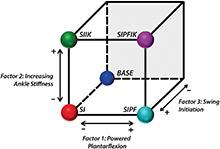
A partial factorial design was used to evaluate the contributions of three factors: powered plantarflexion, increasing ankle stiffness, and knee swing initiation.
Image courtesy of PLOS One.
Researchers from the Rehabilitation Institute of Chicago and Northwestern University studied how different combinations of active knee and ankle assistance affect the walking mechanics of people with a transfemoral amputation. The study assessed the relative contributions of stance phase knee swing initiation, increasing ankle stiffness, and powered plantarflexion as three subjects with unilateral transfemoral amputations walked over ground at their self-selected walking speed. Five combinations of knee and ankle conditions were evaluated regarding the kinematics and kinetics of the prosthetic and intact legs using repeated measures analyses of variance. The researchers found that eliminating active knee swing initiation or powered plantarflexion was linked to increased compensations of the ipsilateral hip joint during the subsequent swing phase.
The elimination of knee swing initiation or powered plantarflexion also led to reduced braking ground reaction forces of the amputated and intact legs, and influenced both sagittal and frontal plane loading of the intact knee joint. Gradually increasing the prosthetic ankle stiffness influenced the shape of the prosthetic ankle plantarflexion moment, more closely mirroring the intact ankle moment. Increasing ankle stiffness also corresponded to increased prosthetic ankle power generation (despite a similar maximum stiffness value across conditions) and increased braking ground reaction forces of the amputated leg.
The researchers noted that although the study can be considered a preliminary evaluation due to the relatively small sample size, convincing and unique trends were found that revealed compensations that occur bilaterally across multiple joints when specific aspects of active assistance are added or removed. “These findings further our understanding of how to deliver assistance to transfemoral amputees walking with powered knee and ankle prostheses,” the study concludes.
The study was published online January 25 in PLOS One.




